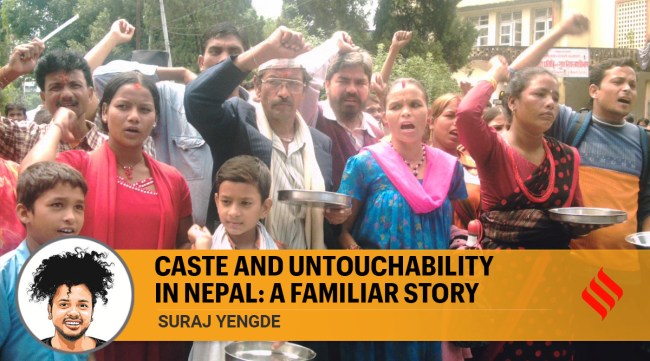Opinion Caste and untouchability in Nepal: A familiar story
Due to the absence of a solid political force lobbying for the rights of the Dalits, the Dalit population has been organising under civil societies mostly aided by some cultural and social organisations.
 The poor in Nepal are disproportionately Dalits, Janajatis and Muslims compared to Brahmins and Newari, also known as Khas-Aryas. (Express)
The poor in Nepal are disproportionately Dalits, Janajatis and Muslims compared to Brahmins and Newari, also known as Khas-Aryas. (Express) Nepal’s caste system functions alongside India’s history in many ways. Credited as an extension of the Hindu republic, the function of caste was introduced around 200 AD in the Valley. The introduction of untouchability was brought in around 600 AD. Aahuti, one of Nepal’s leading scholars and brilliant minds, in his book Nepalma Varnabyawastha ra Barga Sangharsha, traces the presence of castes encoded in the Licchavi era (400-740 CE) stone inscription then advanced by the Malla dynasty.
In 1854, the caste system was strictly encoded along the lines of Manusmriti, known as Muluki Ain (Country Code of Nepal, 1854). This formally acknowledged and regulated the castes into four varnas. Like Manusmriti, the Muluk Ain described the roles of castes, classified those with untouchable rank, and imposed injunctions upon them. While it took another 110 years to revisit this constitutional code of Nepal, the King established Nepal as a “Hindu State” in 1963, suspending the short democratic rights and paving a path towards theocratic autocracy and deepening poverty for the majority. The poor in Nepal are disproportionately Dalits, Janajatis and Muslims compared to Brahmins and Newari, also known as Khas-Aryas.
The Hindu state assimilated the traditional, non-Hindu indigenous communities into the caste fold, thus creating a three-tier social order – Tagadhari (thread-bearing castes), Matwali (Janajatis and ethnic tribes known as ‘alcohol drinkers’) and Pani Nachalne (lower touchable and untouchable castes).
Though there is a reservation policy in place, it continues to receive intense pushback from the Nepali dominant caste community. The idea of merit and equality is placed before the beneficiaries of state-sanctioned reservation policy. Despite the reservation system, the desired representation in the House, as well as the bureaucracy and judiciary of Dalits, is depressingly low.
There is no Dalit judge in the Supreme Court of Nepal. The government services are unwelcoming to the Dalits. Less than 0.7% of Dalits hold important posts in the civil services despite reservation, whereas Brahmins, whose population is 12.7%, occupy 70% of posts. The number of Dalits having a share in the state is 4.5% as opposed to the 14% mandated to reflect their representation.
Due to the absence of a solid political force lobbying for the rights of the Dalits, the Dalit population has been organising under civil societies mostly aided by some cultural and social organisations.
Contemporary Dalit leaders of Nepal are organising under a broader coalition of Dalit and Janjati, comprising approximately 36% of the Nepalese population. Together with the Muslims and the Madhesis, they form a formidable force.
There is a vibrant civil society that has been pushing for change since the 1950s. Prominent leaders to emerge from the anti-caste Nepali Dalit activism are Sahashra Nath Kapali, Mohan Lal Kapali, T R Bishwakarma, Mithai Devi Bishwokarma, D B Parihar, Dhan Man Singh Parihar, Padam Sundas, and Jawahar Roka.
Dalits are negligibly present in parliament and provincial assemblies. Those who are nominated by the party as proportionate representatives are mere mouthpieces who have to adhere to the party command. The strength of Dalits in the House of Representatives should be 38, however, only 16 Dalits are present, and one member was directly elected from Community Party of Nepal-UML.
When the Maoists took power, they sent a sizable chunk of Dalits to the parliament. It is because the major source of the Maoist struggle were Dalits, so it certainly pushed the post-revolutionary state to have a representation. However, like everywhere else, political parties, civil societies, and educational and social leadership are manned by Brahmins. They control the resources and direct the narrative suiting their interest. All the Prime Ministers of Nepal so far have been Brahmin males. The political leadership of all the parties is also governed by the singular Brahmin castes.
The Dalits of Nepal need cultural revivalism. They need to look up to their icons in history and create a counterculture that is distinct and independent of the dominant castes. The ruling castes have always used diversion and accusation against any anti-caste, Dalit assertion. Therefore, the Dalit history of Nepal has to take centre stage. The legendary activists and forebearers of the community have to be the beacons of hope.
Festivals and community stories have to inform the Dalit pride drawn from experience and struggle. The real sweat-toiled generations have to be recognised by the Dalits through the celebration of their ancestors. They need notable dates that the community can congregate and celebrate. They ought to demonstrate their unique presence as a community.
Ambedkar is an accepted icon of the anti-caste struggle worldwide. In Nepal, too, he was celebrated when he visited Kathmandu for the Fourth World Fellowship of Buddhists Conference in 1956. The leader of Dalit community apprised Ambedkar of their problems and sought counsel. Some of them have been organizing under Jat Tod Mandal (1951) while after his visit other organizations were formed. Of them, the first Dalit women-led organisation in Nepal was the Pariganit Nari Sangh (1955) under the leadership of Mithai Devi Biswakarma. Among other notable organisations to follow was the Rashtriya Acchut Mukti Parishad (1958).
Following this, a generation of activists and writers emerged from the fertile land of the Nepali revolution. Among them, Jawahar Roka, a fiery Ambedkarite who named his house “Ambedkar Kuti”, wrote to a respected writer, ambassador, and statesman from the Dalit community, Padam Sundas, to establish a respectable, independent Dalit cultural history. This letter talks of how history is constructed by the dominant caste through their capacity to determine what constitutes a Dalit culture, and how it values “certain aspects of culture as an essential heritage to be cultivated and passed on and others as negligible and dispensable”. This means the basic facilities of culture have to be supervised by the hegemonic powers, even in the moments and activities of subaltern assertion. Roka exercises Ambedkarite caution in establishing his narratives. Roka advocated for conversion to Buddhism.
The same Buddhism that has attracted me towards Nepal this time. My next stop is Lumbini, the birthplace of Buddha, where Nepal is most proud of its history.






